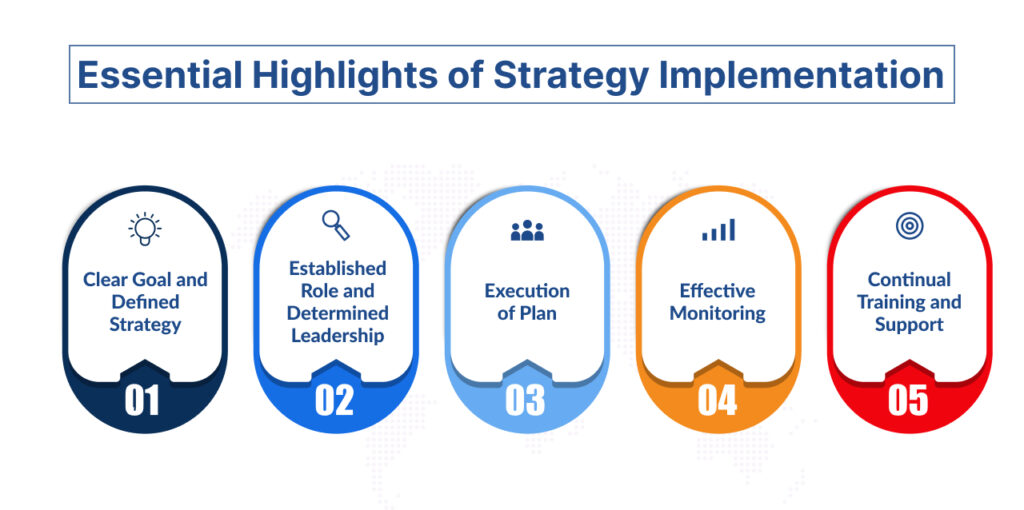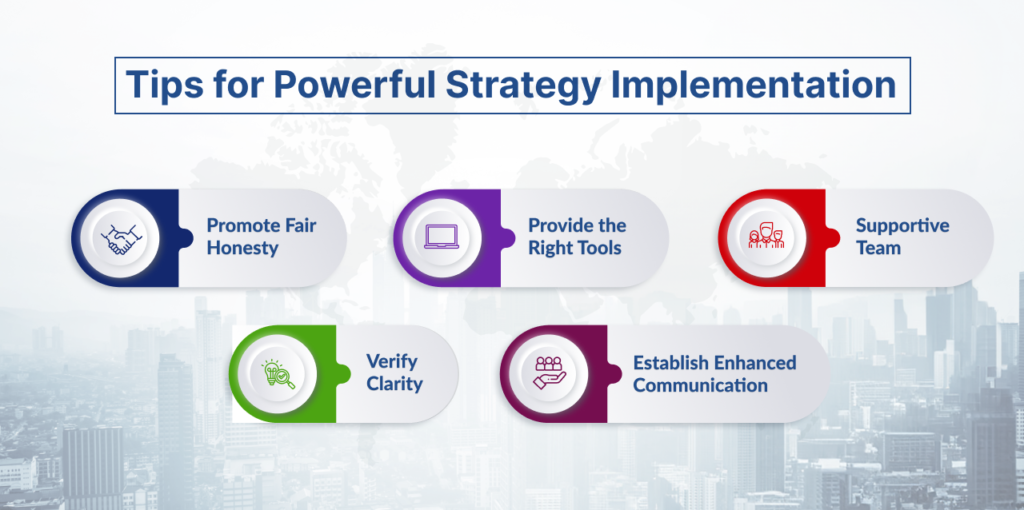Strategic Implementation: The Crucial Link Between Vision and Value
An organisation’s future vision is not just a dream but a practical goal that can be achieved through the strategic roadmap. Like a light, this roadmap guides your organisation towards its goals and fuels its passion, translating your vision into tangible results for long-term success.
This article will cover all the essential strategic implementation processes to uncover their crucial significance, methods, benefits, and challenges.
Defining Strategy Implementation: From Vision to Action
Imagine a puzzle. Your company’s vision is the picture on the box, and strategy implementation is the process of putting all the pieces together to create that picture in reality. Effective implementation, a process that empowers your team, requires the development of plans, resource allocation, and team management to achieve common goals. A strategy must ensure meticulous planning, management, and communication for a correct execution.
Here are some vital pillars to follow:
- Goal Setting– Maintain clear and time-bound targets that everyone can understand and match individual’s goals.
- Action Planning– Take your work slow and break it down into smaller processes to achieve your goals.
- Resource Management– Determine what you need to get the job done, such as money for expenses, the right skills, confidence, and technology tools.
- Communication– Effective communication is not just a part of strategy implementation; it is the backbone that ensures the smooth flow of strategy plans that match the organisation’s visions. Make sure that everyone understands their role and that their work contributes a positive impact within the organisation.
Importance and Benefits of Strategic Implementation
The business world is facing unseen challenges, and to overcome them, we need a defined strategy with clear instructions. Strategy implementation is vital because it involves action, not just ideas, which helps the team understand that the discussed methods are practical. It is also helpful for team members to communicate thoroughly and implement the right tools and strategies to facilitate productive results. These benefits instil confidence and optimism in the team, knowing that their efforts lead to success.
Lets now delve into its benefits that are in the tabular form:
|
Benefits |
Descriptions |
|
Improved Clarity |
|
|
Enhanced Efficiency |
|
|
Increased Accountability |
|
|
Informed Decision-Making |
|
|
Positive Emlopyee Engagagement |
|
Aligning Vision with Strategy Implementation
A successful strategy implementation is needed to bring an innovative approach towards the company. Here are the points that align with the future vision to achieve a stable perspective:
- Articulation of Vision– When communicated effectively, a clear vision sets a tone for the strategy, inspiring the employees and guiding them in a purposeful direction.
- Planning Strategically– Strategy development is needed to achieve long-term goals, and it also includes understanding market demands, competitive prospects, and internal and external capabilities.
- Alignment of Culture– The organisation should respect the vision and strategy to foster improved work culture, innovation and constant improvement.
Essential Highlights of Strategy Implementation

A project reaches its goals with the help of well-planned thoughts and applying strategic implementation to reach the final goal. Here are the potential highlights that cover the implementation process completely:
- Clear Goal and Defined Strategy– Setting a well-defined and clear goal helps an organisation achieve it quickly. Break down your strategy into a chart or PowerPoint presentation for the team to maintain the workflow. A visual draft of the strategy always prompts a positive response, making the team’s goals achievable. A company with a precise alignment of the strategy always meets the vision’s goal.
- Establish Roles and Determined Leadership– Defining the role of the team brings excellent performance and accountability. When working on a project that defines and succeeds in the goal, transparency is needed. Choose a determined leader who can lead the entire project until its deadline. Ensure each team member handles their responsibilities and collectively overcomes the project challenges to meet its end goal.
- Execution of Plan– Once the plan and project are assigned to their team, start the execution process. When working on a project, take the initial steps and make a progress report to check its direction. Finally, use your critical thinking and problem-solving skills to reach the end of the goal.
- Effective Monitoring– Update the team on the project’s progress to understand where you face challenges and how to overcome them with new ideas. Motivating the team for the project is an excellent way to reach the final point while maintaining productivity. Additionally, each team’s progress must be monitored to identify the challenging areas of the project and improve it after that.
- Continual Training and Support– A supportive team extends and addresses a great deal of knowledge and solves problems effectively using innovative ideas. The team must encourage each other’s work performance to reach one common goal.
Tips for Powerful Strategy Implementation

A project needs step-by-step consideration and strategic implementation of the ideas to reach its goal. Here are the following tips that include:
- Promote Fair Honesty– Ensure fair and honest communication between you and your team. This will reflect a team spirit and help you grow within the organisational space. Honest leadership builds trust among team members and fosters an accomplished environment. It will also help the team grow and give unbiased reviews of their work performance.
- Verify Clarity– The final goal in the plan requires clarity so that a strategy can be implemented to achieve it. Once all the team members are clear, productivity work will only occur. Hence, a clear vision is necessary to meet structured-oriented goals.
- Supportive Team– In an organisation, there should be understanding between teammates who inspire and support each other whenever a problem arises. A supportive team member always overcomes challenging issues with an effective solution.
- Provide the Right Tools– Every workspace requires concrete tools to complete the task successfully. Team members should have the right tools to reach the goals in time.
- Establish Enhanced Communication– In every large company, effective communication between the managers and team members is required to run the work smoothly. Every company provides a messaging app and some right tools to measure the proficiency of work and informed-driven outcomes.
Strategic Implementation: Overcoming Challenges
While implementing the strategy, the team can face challenges while reaching its goals. Here are some common pitfalls to guide them:
- Shortfall of Clarity: Before the project starts, ensure your strategy is clear, concise, and well-communicated to all stakeholders. Clarifying project doubts is useful before they hinder the implementation process.
- Resistance to Change: Misunderstandings while working on a project can lead to confusion and work delays. People naturally resist change, and to overcome this situation, Anticipating resistance can impact the whole team’s ability to reach the common goals.
- Miscommunication: Miscommunication can occur in any team, so it’s advised to have open and transparent communication throughout the implementation process to address concerns and celebrate successes.
- Absence of Monitoring and Evaluation: Don’t set an autopilot strategy. Be Regular in your work and monitor your progress to adopt a strategic approach.
Bottom Line
Strategic implementation is a multifaceted approach that turns vision into value and requires attentive planning, project execution and continuous improvement to reach the final evaluation of the goal. In an organisation, to achieve an objective strategy, the team needs a clear and defined vision before attaining significant growth.
Turning the vision into value is challenging, but the proper methods and approach can lead to achievable growth and stability.
Strategic Implementation: FAQs
Q1. Define the role of leadership in strategic implementation.
The role of leadership is emphasised because leaders process the plan strategically and guide the team to reach its goals. They implement clear decisions, motivate the team, and manage conflicts properly. Influential leaders ensure the strategy is executed as planned to achieve the result without facing any challenges.
Q2. What do you mean by strategic implementation?
Strategy implementation is about executing a plan to reach the desired goals. In this process, brainstorming ideas can help formulate action by implementing strategic plans.
Q3. What are the five stages of strategy implementation?
- Define your Vision
- Collect Analysed Information
- Implement Your Strategy
- Formulate a Clear Strategy
- Control and Evaluate
Q4. What are the seven factors of strategic implementation?
- Set clear goal
- Determine roles and responsibilities of team members
- Assign work
- Process and Monitor
- Conclude the job
- Reflect and Review
- Revise and Adjust
Q5. What are the four aspects of strategy implementation?
Strategic implementation follows four aspects: Quality, Quantity, Time and Information.

- Amity University Online MBA
- Shoolini University Online MBA
- Sharda University Online MBA
- Uttaranchal University Online MBA
- Symbiosis Online MBA
- Jain University Online MBA
- Manipal Online MBA
- OP Jindal University Online MBA
- LPU Online MBA
- NMIMS Online MBA
- DY Patil Online MBA
- UPES University Online MBA
- IIM Kozhikode Online MBA
- MICA
Online MBA Specialisations
- Amity Online MCA
Online MCA Specializations
Copyright ©2025 All Rights Reserved by Hike Education Pvt. Ltd.

.png)

.png)




